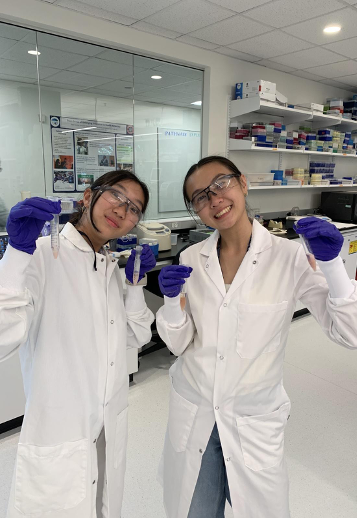Priya E.
- SEP

- Sep 18, 2025
- 4 min read
The past two weeks at the Fred Hutch Cancer Center have gone by in a blur. I’ve experienced research in a way I never imagined. Moving from tours of labs and the Allen Institute to performing hands-on lab work made me feel like I was able to see and make an impact through my time here. For me, understanding the science of how to heal is personal. Whenever I visited my grandparents in India, I saw how a lack of resources impacted their health. As diabetics, they struggle with wounds that are amplified by their body’s weakness, a problem that is even worse due to antibiotic resistance. It made me curious about the world of tissue repair and how we can understand the fundamental rules of healing to intervene and play a role in the process of cancer or other diseases.
One of my favorite activities was the CRISPR lab. Being able to micropipette and walk around the lab completing a protocol felt as if it was with a true purpose. And that’s what mattered to me. We were basically on a mission, just like scientists. The first step actually began days before we implemented the CRISPR Cas9 system. In order to be able to edit a single gene utilizing CRISPR we would need to find it and then make a whole load of copies of it. By using cycles of heating and cooling, or in other words a Polymerase Chain Reaction (PCR), we were able to undo the bonds of the DNA and replicate a specific segment containing our target: the BRCA1 gene. The BRCA1 is a tumor suppressor gene associated with breast cancer, meaning that it’s supposed to stop cells from rapidly dividing. However, when there is a mutation, CRISPR becomes the tool to be able to fix the mistake. After our target gene was amplified, we introduced the CRISPR-Cas9 system. The technology is basically a two-step tool. First, there is the Cas9 enzyme which is basically a pair of scissors to cut a specific segment. Then, the guide RNAs (the gRNAs) is what takes the Cas9 scissors to the location of where to cut.

Fig 1.1 Image of my partner and I’s chosen gRNAs and their respective fragment sizes to be correlated for the later run gel
The final step was the Gel Electrophoresis. This technique would separate the DNA fragments by size utilizing an electric current. As our goal was to delete a piece of the BRCA1 gene, we predicted our edited DNA, as smaller fragments, would travel down farther the gel. Seeing that the band would be lower would be a sign that it successfully worked. Although our results weren’t too clear, it allowed us to understand that science will always have that process of making mistakes and it’s key to understanding what could be done next.

Fig 1.2. Image of my partner and I loading the gel electrophoresis
Learning to edit a gene for the first time myself was inspiring and a talk that really opened my eyes to the other side of gene editing was by Dr. Jeanne. Bioethics is another perspective to gene editing. It’s an understanding of the future and what it could mean to edit genes on a widespread level. My prior knowledge was just based on GATTACA or A Brave New World (which are my favorite movie and book respectively since they combine two of my favorite things: reading and genetics). Dr. Jeanne challenged us to think beyond what we know and beyond the lab bench itself to what it could mean in the real world. In addition, she also mentioned the use of AI and its rapid evolution. AI is now in our life more than ever, and it’s important to understand its functions and keep in mind the important questions of its use. Not only does AI impact what we see, what we hear, how we think, and what we are able to do computers are becoming a part of our system that ultimately functions. Understanding what’s ethical and what’s okay to use and not to use not only in the realm of genetics but also in AI, the tools that we see on the daily, are so important for the future world.
At the end of the day, the Fred Hutch Pathways Explorers Program was one of those once in a lifetime experiences. I came in to learn more about cancer and what it could mean on the molecular level and came out with understanding the endless possibilities of research, seeing the labs in action, and being able to work on our own mini projects.I would like to thank Dr. Goode, Layan, Lac, Alex, and Shayan for making this a transformative and memorable experience nearly everyday in the program. I would like to also thank the other Pathways Explorer Alumni for their advice and answers to questions of what we had. Finally, I would like to thank all of the speakers, mentors, and lab researchers that allowed us to see a side of science that we would not typically be able to see and jump into this fascinating world, whether that be through their talk or through their labs, it was truly inspiration.







Comments